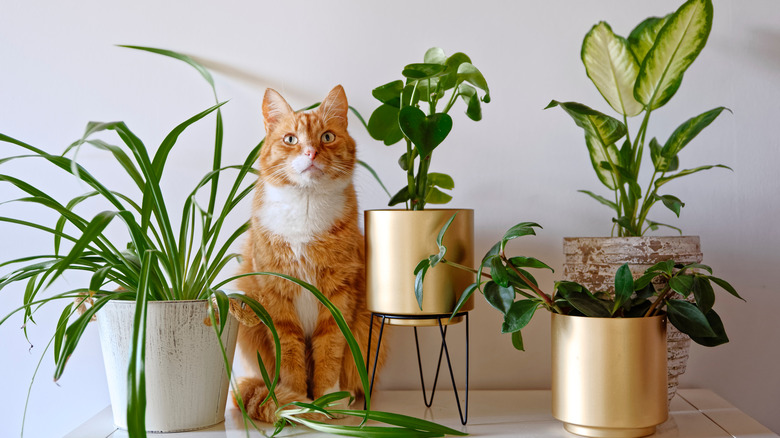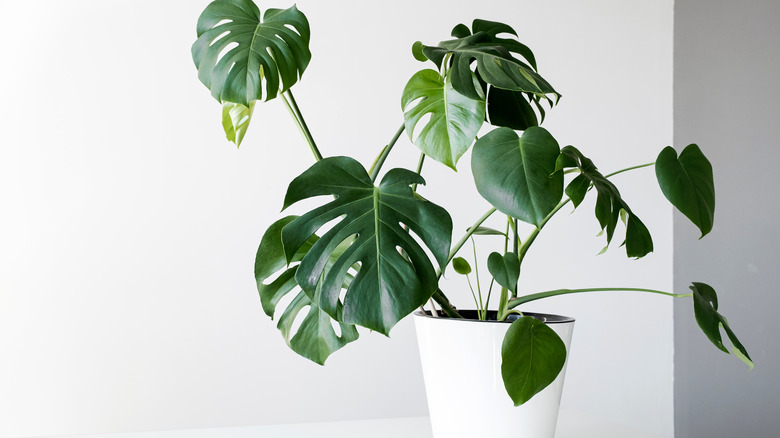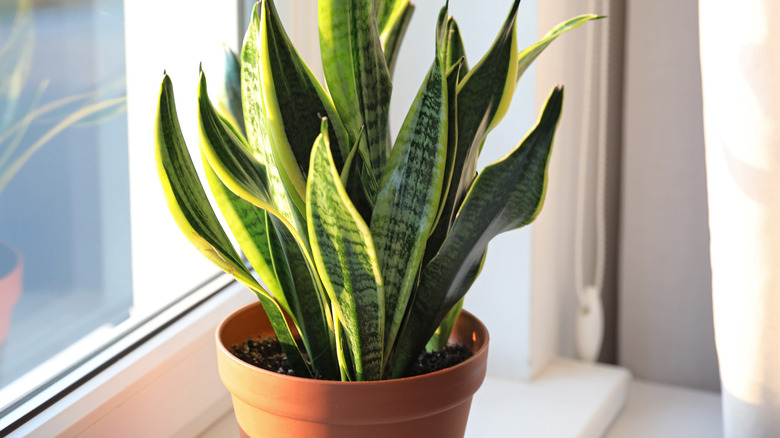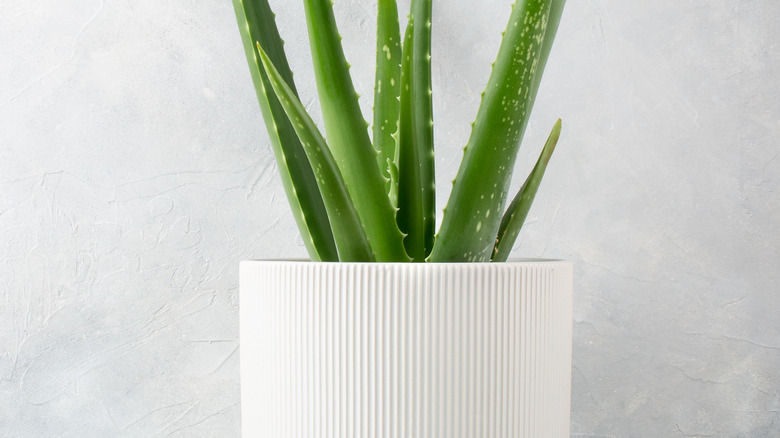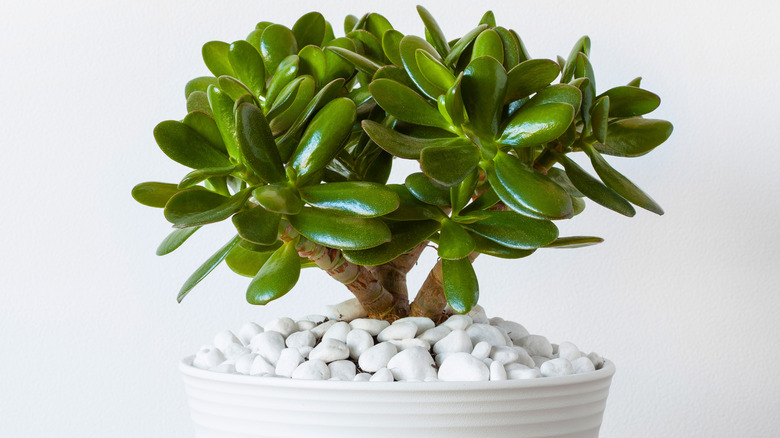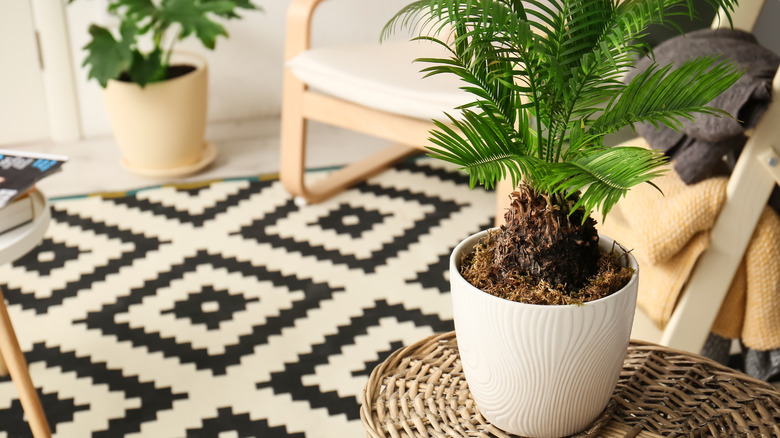The Houseplants You Should Avoid If You Have Cats
Cats are notorious for having a keen sense of curiosity, which is awfully cute. It can, however, get them into trouble, and at times, dangerous situations. If you are a cat lover, you're probably all-too-familiar with their very sweet but nosy personalities — especially when you bring something new into the house. They can be relentless in trying to investigate and even nibbling new plants or bouquets of flowers. It's important to remember that it's their home, too, and there are important things you need to learn about when it comes to choosing plants and flowers in your space.
While houseplants are a perfect choice for giving any room in your home an effortless, boho vibe, pure air, and a pretty brightness to whatever space they're in, you have to choose them wisely. While you might be tempted to go for some plants that are the easiest to grow, proceed with caution. Countless varieties of flowers and plants are highly toxic to cats (and dogs). There are, of course, variances between the amount that may be consumed and potential dangerous side effects in certain plant species, but it's better to play it safe when it comes to your pet.
We've rounded up some of the worst houseplants that you should avoid if you have a cat in your home. If you see one of your favorites on the list and have a fluffy fur baby to look out for, considering a really nice artificial version might be your best bet.
Monstera Deliciosa
With its massive leaves and dramatic, tropical flair, the monstera deliciosa is an ultra-popular indoor plant to decorate with, because it is low maintenance, but can grow enormously to reward you for your efforts. Its Instagram-worthy appearance has made it a total hit on social media time and time again.
More commonly known as the "Swiss cheese plant" — nicknamed as such for the natural cutouts in its leaves — it poses a danger to cats because of the calcium oxalate crystals contained in its leaves. According to the ASPCA, this would be a horrible choice for a cat parent to have in their space. The ASPCA advises that ingestion will cause "intense burning and irritation of mouth," in addition to vomiting, drooling, and even difficulty swallowing. Due to its larger size, you'll be hard pressed to keep it out of your feline's reach, regardless of where you place the plant inside the house. However, if you've got a patio or deck that's off limits to the cats, the plant should be fine out there. House Beautiful suggests that you make sure it's in indirect sunlight, be sure it doesn't get overwatered, and keep the overall environment it's in dry and warm. Under all circumstances, if you decide to keep it out on a deck or patio, be absolutely sure your kitty will not have access to it.
Snake Plant
Also cheekily known as "mother-in-law's tongue," the snake plant is another favorite choice for growing indoors. Gardening Know How even goes so far as to declare them the "perfect houseplants," because they can tolerate weeks of neglect without getting dry or droopy. They're really a great choice for you to have in your home, but not nearly so great for your cats, though. According to the ASPCA, eating the leaves of this snake plant will cause nausea, diarrhea, and vomiting. The American Kennel Club expands on to this and explains that the poison in the plant actually produces a "numbing effect" that can make the throat and tongue swell up. Yikes! Be sure to have kitty stay away from this one.
It's important to note that there are other species of the snake plant and they might be called different things, but all varieties should still be avoided if you have cats. Gardening Know How identifies them as rhino grass, golden hahnii, cylindrical snake plant, and the white snake plant. If you're unsure, carefully research the plant before bringing it home and near your precious cat. Keep in mind that it should be easy to find an artificial substitute you can buy if you really like the look of this particular plant for your decor.
Aloe
Long celebrated for the soothing, healing properties that come from the gel within its leaves, it might surprise you to see aloe plants on this list. While aloe is great for humans, the same doesn't hold true for cats, unfortunately. The ASPCA reports that ingestion will cause vomiting, lethargy, and diarrhea for our feline friends. It's important to seek veterinary assistance right away if you think your cat has eaten aloe, or if you see bite marks on its leaves.
If you don't have a room in the house that is completely off-limits to your cat, you probably won't want to and shouldn't risk bringing the plant into your home. However, this doesn't mean you can't reap the benefits of aloe's medicinal properties. Whether you want to drink aloe vera juice or incorporate it into your beauty routine, you should be able to find a high-quality aloe product at your local health store or you can easily order it online.
Jade Plant
Thought to bring good luck and good fortune to its owner, the jade plant has long been a popular choice for homes and offices. It makes perfect sense that this beauty is also nicknamed the money plant. The small, glossy green succulent doesn't bring the same wealth to cats who nibble on it, though. As a matter of fact, it has quite the opposite effect. The ASPCA warns that the jade plant will cause depression, vomiting, and incoordination if your fur baby gets a hold of it.
If you can guarantee a safe place away from your cat, or you want to try growing it at your desk at work, it doesn't require much effort. Gardening Know How says the most important things a jade plant needs in order to thrive are careful watering and full sunlight. There is a balance you need to maintain, as you would never want this plant to dry out, but you also will not want to overwater, as that can cause root rot. Sufficient fertilizing is important, with Gardening Know How recommending that you fertilize every six months to keep your jade plant healthy and vibrant. But, plan to keep this gem far away from kitty.
Sago Palm
If you love having a tropical vibe in your home, you may find the sago palm is a favorite greenery choice when you're shopping for houseplants, but unfortunately, its toxicity is off the chart for pets. In fact, ABC News reports that it's the number one call to Animal Poison Control in South Carolina. Veterinarians warn that just a few bites can cause death. Even if it doesn't cause death, the full list from the ASPCA is a frightening one, with adverse effects such as increased thirst, melena, icterus, vomiting, coagulopathy, bruising, hemorrhagic gastroenteritis, liver damage, and liver failure. Most plant shoppers have no idea just how dangerous this innocent-looking houseplant is to their pets.
All hope isn't lost if you're desperate to add some tropical flavor to your landscape, though. If your cats are indoors-only, you can grow the sago palm outside. Whether you plant them in the ground or in pots, they'll need plenty of bright light, and the soil will need to drain well (via Plant Care Today). Overwatering will kill the plant, so you will need to let it dry out in between waterings.
According to Architectural Digest, there are plenty of plants that you can safely have around your space if you have a cat. So fear not, because you can still have some fresh greenery to decorate your home — just make sure they are the right ones that won't present any danger to your precious fur baby.
